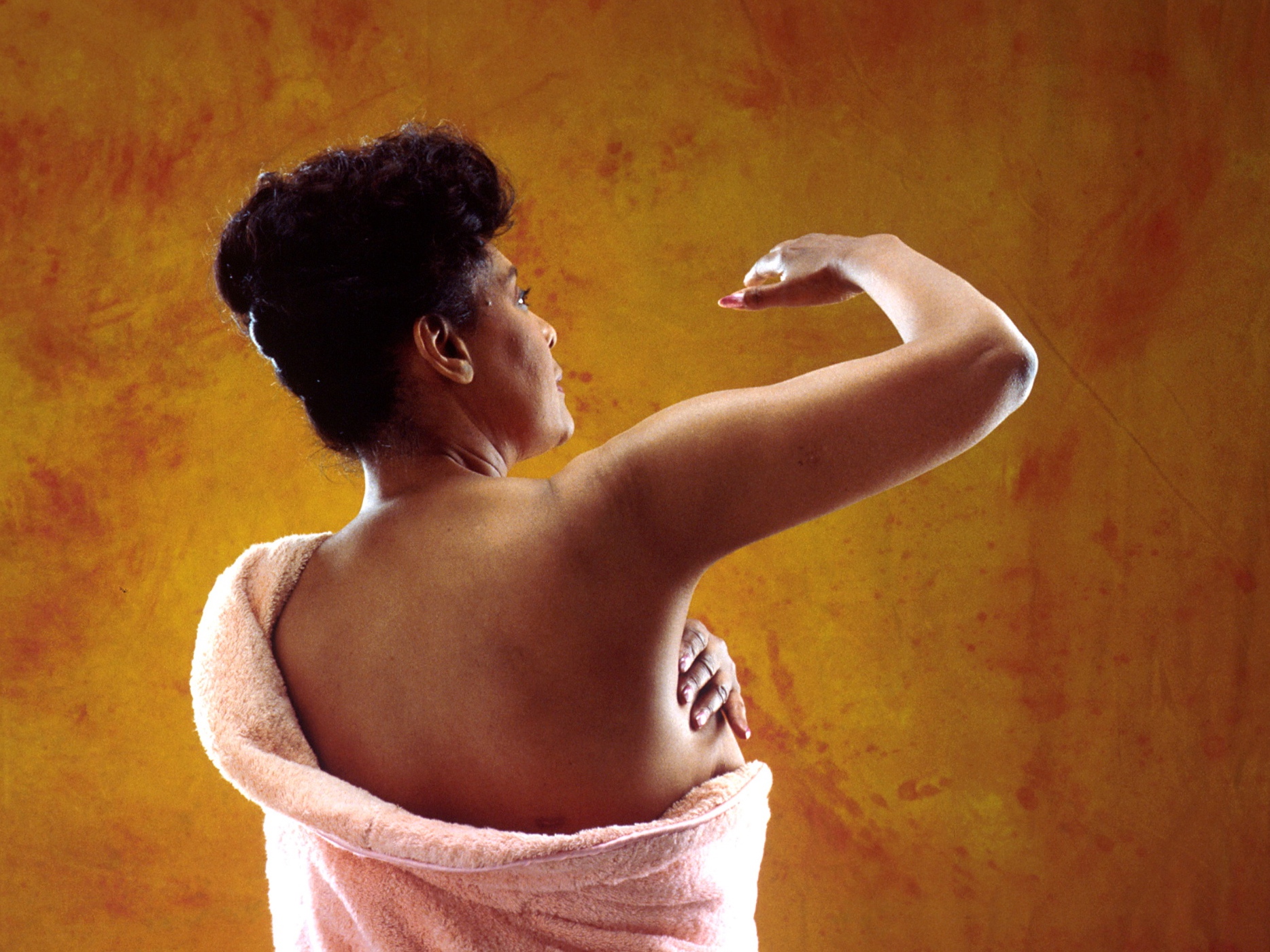Breast Cancer Treatment: The Light-Sound Synergy
Every woman diagnosed with breast cancer wonders if it will come back after completing treatment. The concern is reasonable, since breast cancer can recur at any time, though most recurrences take place in the first five years after treatment. Relapses are typically more aggressive than the initial diagnosis. If the relapse is a metastasis (i.e., spreading beyond the breast), the long-term prognosis tends to be dismal.
How can early-stage breast cancer be treated in a way that will discourage a relapse? The conventional strategy is to follow surgery with radiotherapy and in many cases hormonal therapy and chemotherapy. These treatments will reduce the chances of the disease spreading. Radiotherapy helps eliminate disease in and around the breast area, while hormonal therapy and chemotherapy work to eliminate metastases, the spreading of cancer to other parts of the body.
Photograph credit: By Bill Branson (Photographer), public domain via Wikimedia Commons.
Of course, the downside of these treatments is that they often have major side effects, such as fatigue, hair loss, nerve pain, digestive problems, and immune system dysfunction. Indeed, many women loathe the very idea of chemotherapy because of such treatment-related toxicities. Hormonal therapy and radiotherapy create a great deal of anxiety as well. For these reasons, therapeutic strategies that can eliminate the cancer without having such a toxic impact on the body are strongly desired.
Photomedicine offers a number of light-based therapeutic options for women with breast cancer. One of these strategies is photodiagnosis (PDD), which entails administering a light-sensitizing agent or photosensitizer to the body. This agent accumulates preferentially in cancerous tissue, causing that tissue to fluoresce or “glow”. Making the cancer visible in this way has applications for both diagnosis and treatment.
A nice example of the usefulness of this approach comes from an earlier clinical study out of Women’s Hospital Fontana in Luerlibadstrasse, Switzerland. The purpose of the study was to see whether breast tumors could be distinguished from normal tissues. After giving patients the photosensitizer, the primary breast tumor tissues glowed much brighter (i.e., had significantly higher fluorescence intensity) than the surrounding normal tissue of the breast.
As reported in the January 2001 issue of the British Journal of Cancer, the Swiss research team was able to reliably distinguish breast tumors from normal breast tissue in all the patients. The findings also suggested, however, that the particular PDD method used (with the older generation of photosensitizers) would not be useful for detecting lymph node metastases of breast tumors.
Illuminating the Sentinel Lymph Nodes
Despite this last bit of speculation, we now know that light-based methods can be very helpful for finding cancer that has spread to the lymph nodes. Many breast cancer specialists recommend the use of a sentinel node biopsy in order to determine whether there is cancer in the first few lymph nodes into which a tumor drains—the so-called “sentinel” nodes.
With this strategy, the surgeon may remove only those nodes of the lymphatic system that are most likely to contain cancer. This primarily means the nodes located in the axillary or armpit area. If the biopsy is positive, there may be other lymph nodes upstream that contain cancer, i.e., positive nodes. If the biopsy is negative, it’s quite likely that all of the upstream nodes are negative.
To locate the sentinel lymph nodes (SLN) for subsequent biopsy, the physician injects a labeling substance—either blue dye, a radioactive tracer, or both—into the area around the tumor prior to surgery. The dye or tracer follows the same path to the lymph nodes that the cancer cells would take. By either visualizing the color or using a handheld Geiger counter, the physician can then locate the one or two nodes most likely to test positive for cancer. This basic method can result in a high rate of SLN detection. Once the nodes are detected, a treatment plan can be laid out based on the best available evidence.
Though the dye method has several benefits (e.g., ease of use, cost effectiveness, and safety), the SLN detection rate for this method appears to be lower than that of the radioactive tracer method. Unfortunately, the radioactive tracer method results in exposure of healthcare professionals to radiation, and some women are not keen on having radioactive dye injected into their bodies. Moreover, the resolution of the lymphatic drainage pathway is poor when using the tracer method, and for this reason some surgeons prefer to use blue dye alone, or else a combination of the two methods, for detecting the SLN.
The solution could lie with combining blue dye with fluorescence. Studies have reported that the photosensitizer called indocyanine green (ICG) could be used for SLN detection in women with breast cancer. The fluorescence of ICG results in very clear visualization of the lymphatic drainage pathway.
Until recently, very few studies have reported the combined use of ICG with other tracers for SLN detection in patients with breast cancer. The latest clinical trial enrolled 714 breast cancer patients. The combination of ICG fluorescence and the blue dye method resulted in an almost perfect detection rate of 99.6%. The authors propose that this fluorescence method could reasonably replace the combination of blue dye and radioactive tracer methods, as reported online ahead-of-print in the 28 October 2014 issue of Breast Cancer.
Helping Surgeons See What They’re Doing
The “glow” or fluorescence produced by the photosensitizer (upon exposure to light) also can be used to help guide the surgical process. With this method, known as flourescence-guided surgery, the surgeon can actually see the tumor margins around the surgical site during the operation.
At the same time, by concentrating in the lymph nodes, the photosensitizer offers accurate, real-time detection of the SLN during surgery. Thus, the surgeon is able to visualize the SLN more clearly. Interestingly, however, this fluorescence does not seem to be able do differentiate positive nodes from negative nodes—that process still requires biopsy and analysis under a microscope.
In the foreseeable future, one can envision surgeons first infusing the photosensitizing agent, then using PDD to guide the surgery and perform the procedure in a way that maximizes the surgical outcome. Ideally, the surgery would be followed by the use of a photodynamic treatment in which the light source is inserted into the area from which the tumor was removed. The light treatment then destroys any residual cancer cells in the area.
This approach, which has been endorsed by Professor Clemens Lowik of Leiden University Medical Center and other leading-edge PDT researchers, may represent the future of breast cancer surgery. By immediately following surgery with PDT, the approach helps resolve one of the main limitations of conventional surgery—that of residual cancer cells that cannot be eliminated using additional or more aggressive surgery without substantial damage to the surrounding normal tissues.
Light and Sound: A Dynamic, Therapeutic Synergy
Over the past four decades, photodynamic therapy (PDT) has been increasingly used for the treatment of range of human tumors. A limitation to the successful application of PDT has been light’s inability to penetrate deeply into tumor tissues. For this reason, it has been widely assumed that only small tumors could be treated with PDT, and that larger tumors would require a combination of techniques, such as PDT and radiotherapy.
The ideal combination would be a non-toxic one. To this end, a novel complementary technique has been introduced in recent years. This method entails the therapeutic use of sound waves, or what is called sonodynamic therapy (SDT). The patient first ingests a sonosensitizer, a drug that can be activated by ultrasound. The body transmits ultrasound far more efficiently than light, and this could prove advantageous when treating deeper or larger tumors.
Ultrasound’s role works in much the same way that light activates a photosensitizer—that is, activating the agent after it has accumulated in the tumor tissue. With SDT, however, the sensitizing agent is activated by ultrasound rather than by light. To date, few studies on SDT have been published, in part because it has been difficult to finding a drug suitable for clinical use.
Recently, however, a novel sonosensitizer called Sonoflora 1TM (SF1) was developed by the late Donald Burke, MD, of Advanced Technologies in Boston, Massachusetts (USA). This agent is a chlorophyll derivative that happens to have both sonodynamic and photodynamic activities. The combined sonodynamic-photodynamic therapy approach is abbreviated as SPDT. Experimental studies indicate that PDT and SDT may work in either additive or synergistic ways.
Along with a plethora of laboratory studies, several well-documented cases of tumor regression have been described in patients with metastastic cancers. In all three cases, Sonoflora-based SPDT was well tolerated and virtually free of toxic effects. Unlike chemotherapy and radiotherapy, SPDT did not have any harmful effects on the bone marrow or digestive tract, nor did it damage any key organs such as the heart, lungs, kidney, liver, or spinal cord. The initial findings were published in 2009 in the journal Integrative Cancer Therapies.
In that report, SPDT was claimed to be even safer than conventional PDT because it did not require the insertion of optical fibers (fiber optics) into the body. No photosensitive reactions were reported as so often happens with the older-generation photosensitizers. The main side effect of SPDT was pain or discomfort in the tumor region during the treatment. An in-depth assessment of the cancer-fighting power of SPDT was published online ahead-of-print in the 30 October 2014 issue of Ultrasonics Sonochemistry.
Finally, a recent review of the research on SPDT confirms that the light-sound synergy is indeed a promising new treatment for patients with cancer. This approach exploits PDT’s ability to selectively target the tumor with minimal side effects, while SDT further amplifies the tumor-killing impact. The authors note that porphyrins are the most promising group of substances that have both light- and sound-sensitizing potential, as reported in the September 2014 issue of Anticancer Research.
Support us by buying our book, The Medicine of Light, and ebooks from our Photoimmune Discoveries eBook Series.
Sources
Inoue T1, Nishi T, Nakano Y, Nishimae A, Sawai Y, Yamasaki M, Inaji H. Axillary lymph node recurrence after sentinel lymph node biopsy performed using a combination of indocyanine green fluorescence and the blue dye method in early breast cancer. Breast Cancer. 2014 Oct 28. [Epub ahead of print]
Tong M, Guo W, Gao W. Use of Fluorescence Imaging in Combination with Patent Blue Dye versus Patent Blue Dye Alone in Sentinel Lymph Node Biopsy in Breast Cancer. J Breast Cancer. 2014 Sep;17(3):250-5.
Pleijhuis R, Timmermans A, De Jong J, De Boer E, Ntziachristos V, Van Dam G. Tissue-simulating phantoms for assessing potential near-infrared fluorescence imaging applications in breast cancer surgery. J Vis Exp. 2014 Sep 19;(91):51776.
Guo W1, Zhang L, Ji J, Gao W, Liu J, Tong M. Evaluation of the benefit of using blue dye in addition to indocyanine green fluorescence for sentinel lymph node biopsy in patients with breast cancer. World J Surg Oncol. 2014 Sep 20;12:290. doi: 10.1186/1477-7819-12-290.
Ladner DP, Steiner RA, Allemann J, Haller U, Walt H. Photodynamic diagnosis of breast tumours after oral application of aminolevulinic acid. Br J Cancer. 2001; 84(1):33-7
Sadanala KC, Chaturvedi PK, Seo YM, Kim JM, Jo YS, Lee YK, Ahn WS. Sono-photodynamic combination therapy: a review on sensitizers. Anticancer Res. 2014 Sep;34(9):4657-64.
Wang P, Li C, Wang X, Xiong W, Feng X, Liu Q, Leung AW, Xu C. Anti-metastatic and pro-apoptotic effects elicited by combination photodynamic therapy with sonodynamic therapy on breast cancer both in vitro and in vivo. Ultrason Sonochem. 2014 Oct 30. [Epub ahead of print]
© Copyright 2014, Photoimmune Discoveries, BV






 English
English Français
Français Deutsch
Deutsch Nederlands
Nederlands